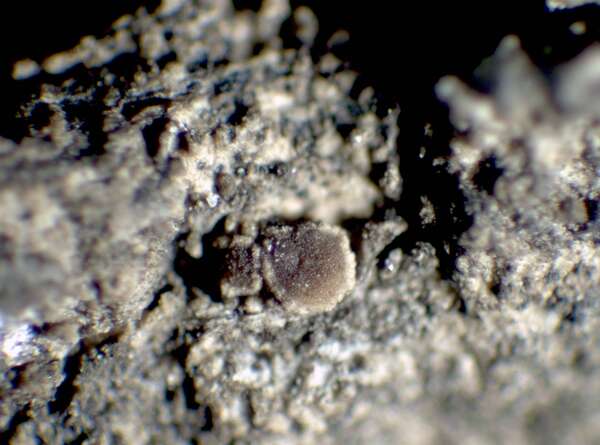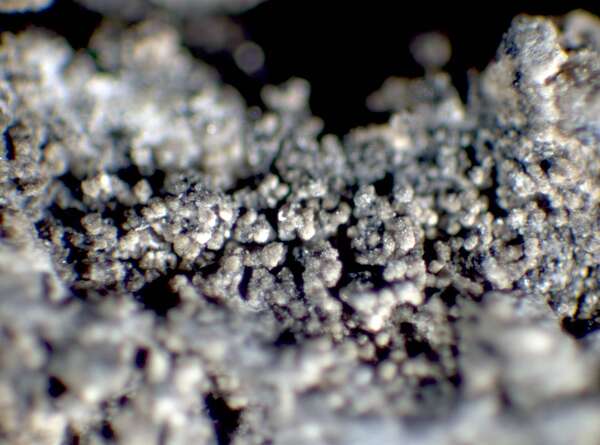Rinodina nimisii Giralt & H. Mayrhofer
in Giralt & al., Lichenologist, 27: 16, 1995.
Synonyms:
Distribution: N - Lig (Giordani & Incerti 2008, Giordani & al. 2009). C - Sar (Giralt & al. 1995).
Description: Thallus crustose, episubstratic, well-developed, continuous, greyish-green, brownish or olivaceous, indeterminate, entirely blastidiate, without a distinct prothallus. Blastidia up to 125 µm thick, with a slightly pruinose and rugose appearance due to surrounding projecting hyphae. Apothecia at first lecanorine, usually becoming biatorine when old, abundant, scattered or confluent, subimmersed, broadly attached, up to 1 mm across, with a black, concave to flat, rarely convex disc, and a thin, entire or blastidiate, soon excluded thalline margin; proper margin usually visible as a parathecial ring within the thalline margin. Thalline exciple 30-70 µm wide laterally; proper exciple indistinct or up to 10-20 µm wide laterally, expanded to 20-30 µm in upper part; epithecium brownish black; hymenium colourless, 50-75 µm high; paraphyses up to 2 µm thick at mid-level, the apical cells 3-5 µm wide; hypothecium colourless, 80-100 µm high. Asci 8-spored, clavate, the K/I+ blue tholus penetrated by a faintly amyloid apical cushion with parallel or diverging flanks, the wall K/I-, surrounded by a K/I+ blue outer layer, Lecanora-type. Ascospores 1-septate, brown, ellipsoid, (10-)12-16(-18) x 6-8.5 µm, without a well-developed torus, swollen in K and strongly warted when mature, Dirinaria-type, with ontogeny of type B (apical thickenings visible before the insertion of the septum). Photobiont chlorococcoid. Spot tests: K-, C-, KC-, P-, UV-. Chemistry: without lichen substances.Note: a Mediterranean-Macaronesian lichen known from several Mediterranean Islands (Corsica Sardinia, Menorca), Portugal, and the Canary Islands, restricted to coastal localities with frequent humid, salt-laden winds, e.g. on Juniperus in sites with sand dunes. It is included in the Italian red list of epiphytic lichens as “Endangered” (Nascimbene & al. 2013c).
Growth form: Crustose
Substrata: bark
Photobiont: green algae other than Trentepohlia
Reproductive strategy: mainly asexual, by soredia, or soredia-like structures (e.g. blastidia)
Most common in areas with a humid-warm climate (e.g. most of Tyrrenian Italy)
Taxon bound to maritime-coastal situations
Commonnes-rarity: (info)
Alpine belt: absent
Subalpine belt: absent
Oromediterranean belt: absent
Montane belt: absent
Submediterranean belt: absent
Padanian area: absent
Humid submediterranean belt: absent
Humid mediterranean belt: extremely rare
Dry mediterranean belt: absent
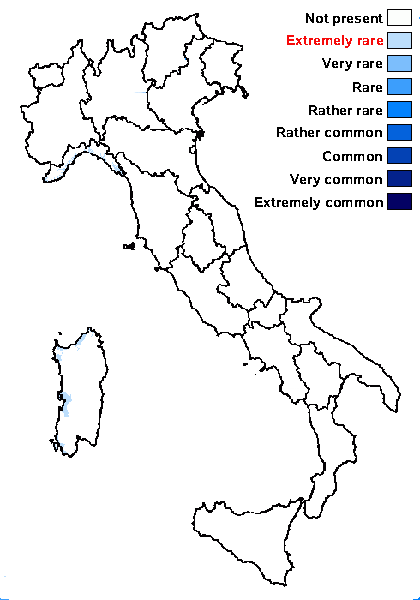
Predictive model
Herbarium samples
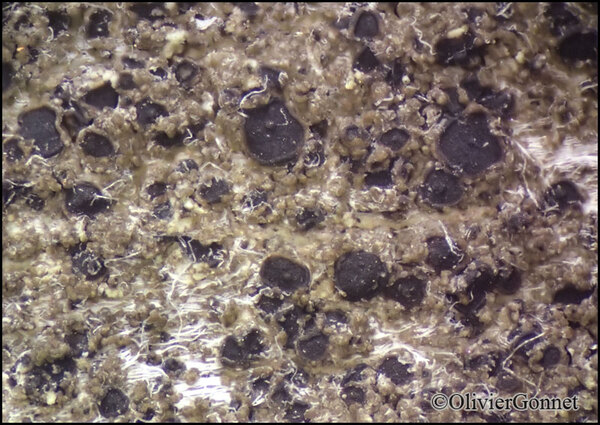
Courtesy Danièle et Olivier Gonnet - Source: https://www.afl-lichenologie.fr/Photos_AFL/Photos_AFL_R/Textes_R2/Rinodina_nimisii.htm
France, Belvédère Campo Moro, punta di Campo Moro, alt. 15 m - Corse
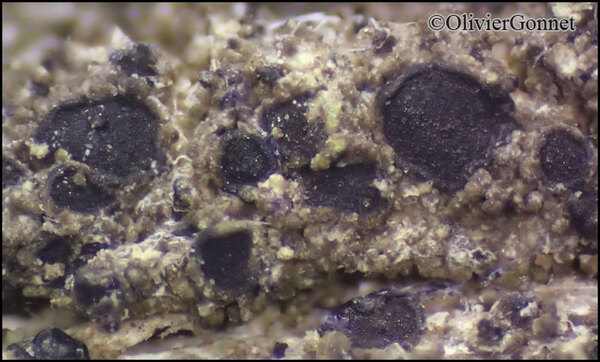
Courtesy Danièle et Olivier Gonnet - Source: https://www.afl-lichenologie.fr/Photos_AFL/Photos_AFL_R/Textes_R2/Rinodina_nimisii.htm
France, Belvédère Campo Moro, punta di Campo Moro, alt. 15 m - Corse
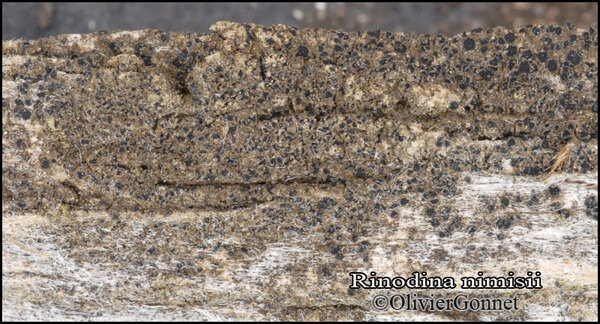
Courtesy Danièle et Olivier Gonnet - Source: https://www.afl-lichenologie.fr/Photos_AFL/Photos_AFL_R/Textes_R2/Rinodina_nimisii.htm
France, Belvédère Campo Moro, punta di Campo Moro, alt. 15 m - Corse
Growth form: Crustose
Substrata: bark
Photobiont: green algae other than Trentepohlia
Reproductive strategy: mainly asexual, by soredia, or soredia-like structures (e.g. blastidia)
Most common in areas with a humid-warm climate (e.g. most of Tyrrenian Italy)
Taxon bound to maritime-coastal situations
Commonnes-rarity: (info)
Alpine belt: absent
Subalpine belt: absent
Oromediterranean belt: absent
Montane belt: absent
Submediterranean belt: absent
Padanian area: absent
Humid submediterranean belt: absent
Humid mediterranean belt: extremely rare
Dry mediterranean belt: absent

Predictive model
| Herbarium samples |

Courtesy Danièle et Olivier Gonnet - Source: https://www.afl-lichenologie.fr/Photos_AFL/Photos_AFL_R/Textes_R2/Rinodina_nimisii.htm
France, Belvédère Campo Moro, punta di Campo Moro, alt. 15 m - Corse

Courtesy Danièle et Olivier Gonnet - Source: https://www.afl-lichenologie.fr/Photos_AFL/Photos_AFL_R/Textes_R2/Rinodina_nimisii.htm
France, Belvédère Campo Moro, punta di Campo Moro, alt. 15 m - Corse

 Index Fungorum
Index Fungorum
 GBIF
GBIF


